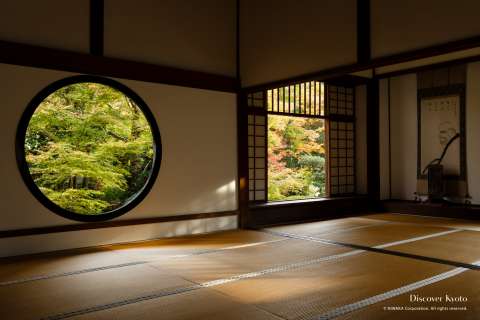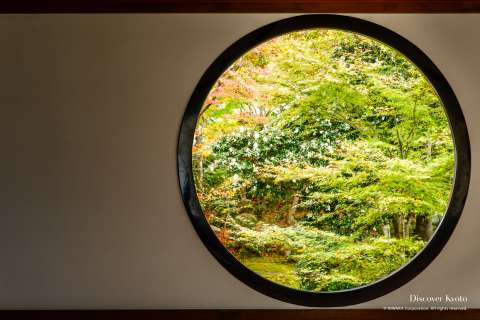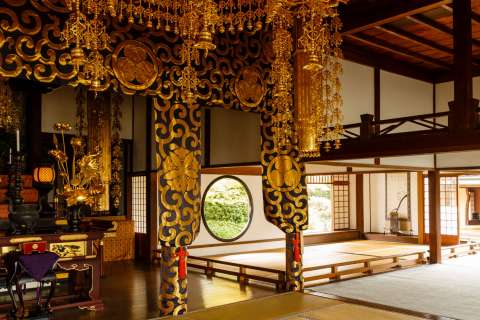Genkō-an|源光庵
Overview

A small temple located in northwest Kyoto, Genkō-an is a Soto Zen temple that is famous for its rather strikingly original windows. People come from all over Kyoto and abroad to sit in front of the “Window of Confusion” and the “Window of Enlightenment” in quiet contemplation. With a history spanning centuries, a somewhat macabre draw of the temple are its so-called “bloody ceilings”, which are made from the floorboards at the site of a mass ritual suicide. Beyond its architectural and historical features, the temple is also home to a charming garden and various pieces of art.
The window of confusion and the window of enlightenment are striking at any time of year and invite visitors to sit awhile and enjoy some quiet contemplation.
Features
The Window of Confusion & The Window of Enlightenment

The most famous aspect of this small temple is the rather striking pair of windows in its main hall. On the right is a rectangular window that is known as the “Window of Confusion”, with each of the four corners representing the suffering mortals are destined to go through in their life: birth, old age, disease, and death. Beside it is the circular “Window of Enlightenment”, whose lack of corners represents the Zen concept of the universe and an enlightened life beyond the pain of mortality. Though these two windows and the view through them are most famous in autumn, they are striking at any time of year and invite visitors to sit awhile and enjoy some quiet contemplation.
Bloody Ceilings

During the Warring States Period a great battle took place at Fushimi Momoyama Castle in 1600 between the forces of Torii Mototada, entrusted with the castle’s defense by Tokugawa Ieyasu, and Ishida Mitsunari. Faced with overwhelming odds and impending defeat, Torii and his remaining forces committed ritual suicide. Once Tokugawa defeated his enemies and became the shogun, he ordered the blood-stained floorboards be installed as the ceilings of several temples, most notably: Genkō-an, Hōsen-in, and Yōgen-in. If you look up at Genkō-an’s temple ceiling, you can see the bloody hand and footprints of warriors who died four hundred years ago, as well as the imprint of a man’s armored side in browned old blood.
Turtle & Crane Garden

“Turtle and Crane Gardens” are a common sight in Japanese temples, as the turtle and the crane are fortuitous symbols of long life. At the small side garden at Genkō-an, you can see the shape of a turtle picked out in carefully designed foliage… but the crane is suspiciously absent. Something of a local joke, be careful if someone asks you if you can “see the crane” in Genkō-an!
History
Formally named Yohozan Hojurin Genkō-an, Genkō-an was originally built in 1346 as a hermitage for the former 2nd Chief Abbot of Daitoku-ji, Tettō Gikō (also known Tetsuo Kokushi). It’s said that while at Genkō-an the abbot had a dream in which a dragon disguised itself as a child and guided him to the western side of the temple. There the abbot found a well he named the Chigoi (Well for Children), which later saved many lives during a famine.
In 1600, following the death of the second “great unifier” Toyotomi Hideyoshi, battle broke out between Tokugawa Ieyasu and other warrior lords for control of the newly built country. In order to gather his allies in the east Tokugawa needed time, which he asked his longtime friend and subordinate Torii Mototada to provide by holding the pursuing forces of Ishida Mitsunari in southern Kyoto by defending Fushimi Castle. Ishida’s assault began on August 27th, 1600, but the siege made little progress for ten days. Torii at this time was potentially still able to mount an escape, but chose instead to remain in order to allow Tokugawa time to rally the eastern army. Addressing his son Tadamasa in a last statement before his death, Torii spoke of his family’s loyalty to the Tokugawa and requested his son take care of his remaining siblings and remain a humble man, imparting his thoughts on life as a warrior and his decision to forfeit his own life.
"For myself, I am resolved to make a stand within the castle and to die a quick death. It would not take much trouble to break through a part of their numbers and escape… But that is not the true meaning of being a warrior, and it would be difficult to account as loyalty. Rather… I will throw up a defense and die a resplendent death. By doing so I will show that to abandon a castle that should be defended, or to value one's life so much as to avoid danger and to show the enemy one's weakness is not within the family traditions of my master Ieyasu... It is not the Way of the Warrior to be shamed and avoid death even under circumstances that are not particularly important. It goes without saying that to sacrifice one's life for the sake of his master is an unchanging principle…The foundation of a man's duty as a man is in 'truth'. Beyond that, there is nothing to say."
In order to take the fortress a message was sent by arrow into the castle threatening that the family of one of the warriors inside had been taken hostage and would be crucified unless he betrayed the others. On September 8th, a tower of the castle was set aflame and Ishida’s men broke into the fortification, where they were met with fierce resistance until only Torii and a few of his men remained alive. Those left then committed honor suicide in the castle rather than submit to capture by the enemy, and Torii Mototada has been immortalized by this show of devotion to his lord in years since.
Tokugawa Ieyasu managed to gather his forces largely in part to the time bought by Torii’s sacrifice, and won the decisive Battle of Sekigahara to cement his position as Shogun. In the aftermath, he decreed that the blood-stained floorboards of Fushimi Castle be turned into ceilings at several temples around Kyoto, including: Yōgen-in (where one can see the outline of Torii Mototada himself), Hōsen-in, and Genkō-an. The purpose behind this was to placate the restless souls of those who had died there, as well as to task those temples with frequent prayers for the deceased. To this day, you can see blood-stained hand and footprints as well as the imprint of a body at Genkō-an alongside a Buddhist altar set up to memorialize Torii and his followers and family.
Genkō-an was revived after neglect in 1694 by Manzan Dōhaku (also known as Manjisan Zenshi), a Zen monk from Kaga Daijō-ji (Ishikawa Prefecture). Manzan Dōhaku, as part of his efforts to revive the Soto sect, established the temple as one that followed Soto Zen practices, converting it from the Rinzai sect of its founder.
During the 1694 repairs, the temple’s main hall was built by Seika Koji, a carpenter brought from Kaga. Enshrined within is the Shakyamuni Buddha, along with his two disciples, as well as a wooden image of Manzan and an image of Reishi Kannon Bosatsu, goddess of compassion. This image of Kannon is particularly well-known as a favorite of the 111th emperor Gosai, and visitors often chant kaiun rishi kanzeon (“I request the good fortune of Reishi Kannon be bestowed upon me”) before the statue.
Access
Address
〒603-8468 京都府京都市 北区鷹峯北鷹峯町47
| TEL | 075-492-1858 |
| FAX | 075-493-5646 |
Admission
- General Admission: ¥400 (¥500 in November)
- Primary School: ¥200
Hours
- General Admission: 9:00~17:00
- Closed: No closing days
Transportation
- City Bus Route ⇒ Bus Route 6 ⇒ Takagamine Genkō-an Bus Stop ⇒ 1 minute walking
Gallery
-




 +19
+19
